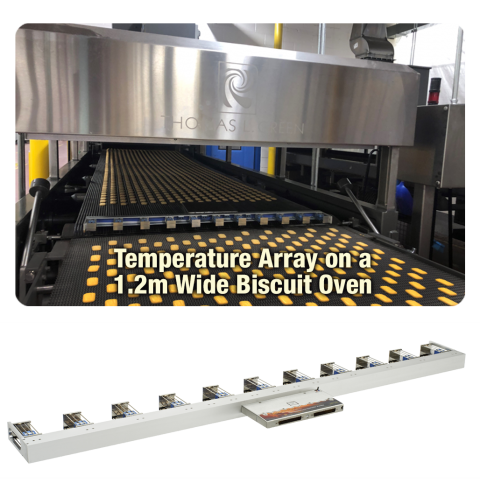Oven temperature profiling systems from Reading Thermal will provide you with information you can use to make reliable data-based decisions about your processes and products.
Headquartered in Sinking Spring, Pennsylvania, the heat transfer experts at Reading Thermal have been studying, measuring, and understanding the commercial baking process for 25+ years. We manufacture and support the SCORPION® 2 Profiling System which is a standard in the baking industry.
The SCORPION® 2 Data Logger is the ‘brain’ of the profiling system. It captures and stores profile data from the Smart Sensors that can be downloaded to a computer for display and analysis. It can capture data from up to 32 sensor/input channels as fast as 10 times per second and can be saved until the user chooses to delete them.
What Can Be Measured
Connecting smart sensors and sensor arrays to the SCORPION® 2 Data Logging Measurement System and passing them through the oven with the product, enables the measurement system to capture the four main baking parameters:
1) Temperature: Oven temperature affects oven-spring, drying/dehydration, and color formation during baking. Temperatures that are too low or too high can also lead to undesirable changes in texture and taste. The Scorpion® 2 Temperature Sensor Array measures temperature at product level, in fixed positions across the conveyor, and delivers a precise picture of temperatures from side-to-side and end-to-end.
2) Humidity: Products passing through a thermal process interact with moisture in the environment. This moisture often comes from the product itself and represents a delicate balance that affects finished product quality in many ways; e.g., the moisture retained in a pretzel after baking can impact its shelf life. Reducing evaporation can also keep the surface of cookies moist, enabling them to stretch without cracking. Bakeries around the world rely on the SCORPION® 2 Humidity Sensor to measure the absolute moisture content of the thermal environment in both heating and cooling processes.
3) Air velocity: In a radiant oven, airflow comes from the moving conveyor, the exhaust system, and natural combustion air currents. In a convection oven, airflow comes primarily from the air distribution plenums. Measuring oven air velocity with the SCORPION® 2 Air Velocity Sensor is critical because airflow affects the coloration, texture, firmness, and baking time of the final product. The profiles that are generated will help you spot airflow differences between baking zones and unwanted air currents at the entrance or exit of the oven that cause inconsistent baking.
4) Heat flux: Oven heat flux is the amount of energy transferred per unit area per unit time from or to a surface. It is the best indicator of oven performance during baking in terms of the product. Many bakeries use these profiles when attempting to produce the same product on two different lines or when trying to transfer product from one line to another. When the heat flux profiles match, the two lines will produce the same product. The SCORPION® 2 Heat Flux Sensor measures convective and radiant heat fluxes at product level and displays the results in Btu/hr·ft2 or W/m2.
If you are interested in oven temperature profiling systems, look no further than the state-of-the-art Reading Thermal SCORPION® 2 Profiling System and our exceptional sensors and sensor arrays. Contact us online, or call (610) 678-5890 Ext. 2 to explore our line of innovative products.

